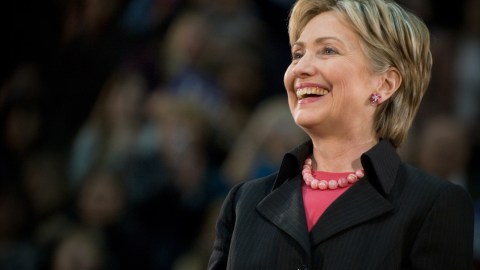Hillary Clinton and The ‘Women’s Point of View’ Conundrum

Hillary Clinton faces a challenge not shared by males running for the U.S. presidency. Women are still rare among government and business leaders. Hence, their choices, even seemingly innocuous ones such as clothing and hairstyle, influence impressions. Georgetown professor of Linguistics, Deborah Tannen, explains that women’s characteristics and actions tend to be more “marked” than those of men — more noticeable and imbued with meaning.
To avoid being negatively “marked” by their choices, many women downplay gender as they attempt to reach the top of their fields. Hillary Clinton’s 2008 campaign took this route. This time, we’re told, she will not do so.
But how does a female candidate for the U.S. presidency help voters determine when being a woman is relevant and when simply being who she is as an individual carries more import? In particular, how does she do so when the tendency among journalists is to emphasize her gender and, for many, to poke fun and even demean her for choosing to wear heels that don’t wreck your feet for life or pants suits for comfort and preferred style?
It isn’t easy.
Essayist and author Dorothy L. Sayers‘ 1946 book Unpopular Opinions offers a still-timely perspective on femaleness being seen as one’s primary category. It results, often, in expecting women to represent the views of their gender rather than their own. “What do women think?” and “What do women want?” are tall-order questions. In most cases, they are unanswerable by any one woman. According to Sayers, it is idiotic to assume that there is a female point of view on the majority of issues. Yet, women who obtain visibility for their work in fields dominated by men are often asked to speak for women.
According to Sayers, this is due to an “unreasonable and irritating” assumption that “all of one’s tastes and preferences have to be conditioned by the class to which one belongs” — particularly the most visible class. This, she argued, is a “very common error into which men have frequently fallen about women.”
There is not, for example a women’s point of view on the health benefits of still versus sparkling water. It is “silly,” Sayers wrote, to suggest that women have a shared “view” on finance. In fact, on most topics in a free society, there is no commonly held male or female view. Female gender may increase familiarity with certain issues or elicit greater sensitivity and agreement, as in the case of equal pay for equal work. But if we don’t discuss issues in terms of the “male view,” it’s important to avoid placing women under a single umbrella.
We are creatures of habit and thinking in terms of categories is one of our more common ones. For Clinton, an important early campaign step will be helping voters and journalists define when gender is meaningful, when it offers special insights, and when it is irrelevant. Effective persuasion for a woman candidate relies on making such distinctions, as it’s very unlikely that we creatures of habit will make them on our own.
Kathleen also blogs here. Her book They Don’t Get It, Do They? about gender communication was just re-released on Kindle.
Photo Credit: mistydawnphoto / Shutterstock.com




